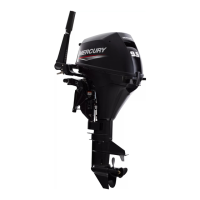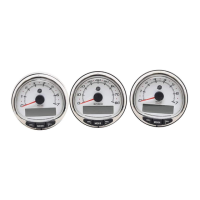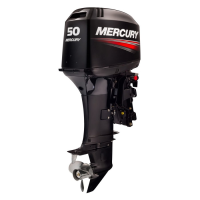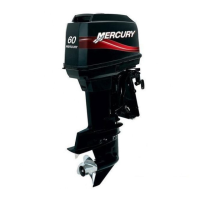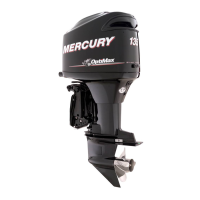2A-12 - ELECTRICAL 90-830234R3 DECEMBER 1997
Description
The outboard ignition system is alternator-driven
with distributor-less capacitor discharge. Major com-
ponents of the ignition system are the flywheel, sta-
tor, trigger, switch box, ignition coils and spark plugs.
The stator assembly is mounted stationary below the
flywheel and has 2 capacitor charging coils. The
flywheel is fitted with permanent magnets inside the
outer rim. As the flywheel rotates the permanent
magnets pass the capacitor charging coils. This
causes the capacitor charging coils to produce AC
voltage. The AC voltage then is conducted to the
switch box where it is rectified and stored in a
capacitor.
The trigger assembly (also mounted under the fly-
wheel) has 3 coils – 3 cylinder models and 2 coils for
4 cylinder models. The flywheel has a second set of
permanent magnets (located around the center hub).
As the flywheel rotates the second set of magnets
pass the trigger coils. This causes the trigger coils to
produce an AC voltage that is conducted to an elec-
tric Silicon Controlled Rectifier (SCR) in the switch
box.
The switch discharges the capacitor voltage into the
ignition coil at the correct time and firing order
sequence.
Capacitor voltage is conducted to the primary side of
the ignition coil. The ignition coil multiplies this volt-
age high enough to jump the gap at the spark plug.
The preceding sequence occurs once-per-engine-
revolution for each cylinder.
Spark timing is changed (advanced/retarded) by ro-
tating the trigger assembly which changes each trig-
ger coil position in relation to the permanent magnets
on the flywheel center hub.
IMPORTANT: If the engine misfires, runs rough or
does not start, the ignition system should be
checked using a Multi-Meter/DVA Tester
(91-99750), or a voltmeter (capable of measuring
400 volts DC, or higher) and Direct Voltage Adap-
tor (91-89045).
Test Procedures
Direct Voltage Adapter (DVA) Tests
WARNING
DANGER - HIGH VOLTAGE/SHOCK HAZARD! Do
not touch ignition components and/or metal test
probes while engine is running and/or being
“cranked.” STAY CLEAR OF SPARK PLUG
LEADS. To assure personal safety, each individu-
al spark plug lead should be grounded to engine.
CAUTION
To protect against meter and/or component dam-
age, observe the following precautions:
• 400 VDC* test position (or higher) MUST BE
used for all tests.
• INSURE the Positive (+) lead/terminal of DVA
is connected to the Positive (+) receptacle of
meter.
• DO NOT CHANGE meter selector switch posi-
tion while engine is running and/or being
“cranked.”
• Switch box MUST BE GROUNDED during
tests. Running or “cranking” engine with
switch box ungrounded may damage switch
box.
* If using a meter with a built-in DVA, the DVA/400 VDC test
position should be used.
NOTE: Test leads are not supplied with the DVA. Use
test leads supplied with meter.
Test procedures and specifications are provided for
checking primary ignition voltage while the en-
gine is running and/or being “cranked.”
TROUBLESHOOTING TIPS:
3 CYLINDER MODELS –
1. Intermittent, weak, or no spark output at one
spark plug usually indicates a bad GROUND,
SPARK PLUG, COIL, SWITCH BOX or TRIG-
GER.
2. Intermittent, weak, or no spark output at all three
spark plugs usually indicates a bad STATOR,
SWITCH BOX or STOP CIRCUIT. A defective
WHITE/BLACK Lead for the trigger will also
cause intermittant, weak or no spark at all 3
cylinders as this lead is the return path for all
3 triggers.

